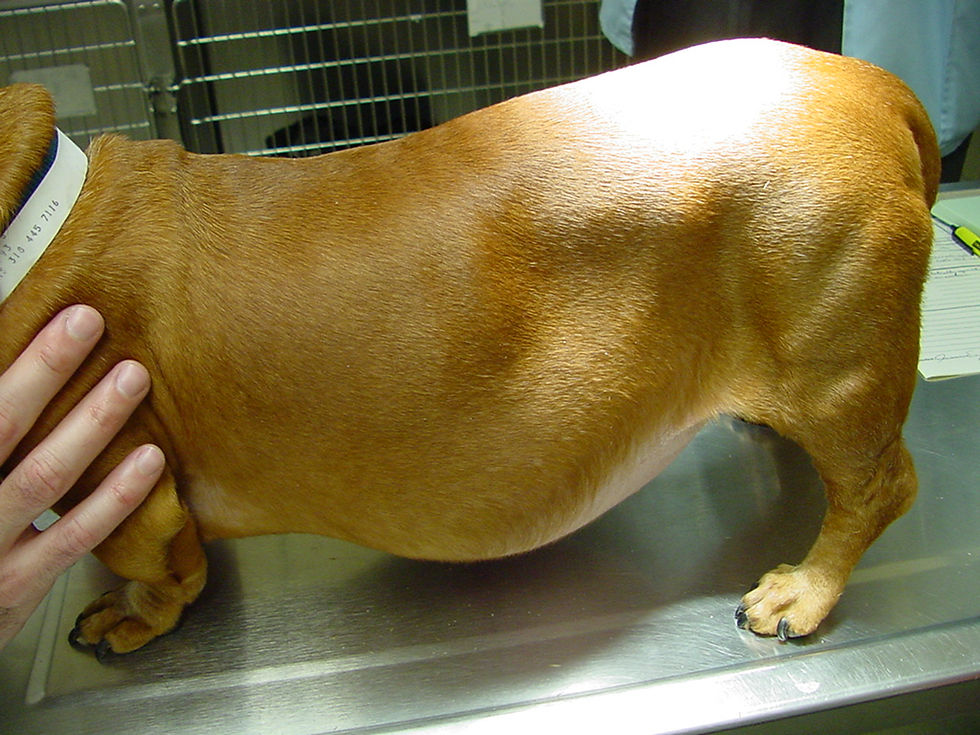Cushing disease
- Megan Donnelly
- Mar 10
- 2 min read

Cushing disease, also known as hyperadrenocorticism, is caused by too much cortisol. Miniature Poodles, Dachshunds, Boxers, Boston Terriers, and Beagles are at increased risk. In most affected dogs (85 to 90%), the cause is a small, benign pituitary tumour. In the remaining 10 to 15% of dogs, the cause is a tumor of the adrenal gland itself.
This condition tends to occur in middle-aged to older dogs. Common signs include increased thirst and urination, increased appetite, heat intolerance, lethargy, a “potbelly,” panting, obesity, weakness, thin skin, hair loss, and bruising. Rarely, calcinosis cutis develops, a condition in which minerals are deposited in the skin and can appear as small, thickened “dots” on the abdomen.
Diagnosis of Cushing disease can be difficult because laboratory test results may be inconclusive and false-positive test results are common in dogs that have other diseases. Veterinarians will run routine and specialized blood and urine tests on dogs that have signs of Cushing disease. Retesting may be needed 3 to 6 months later if test results are inconclusive or if the dog does not continue to show signs. Once the disease is confirmed, additional laboratory tests are usually done to determine whether the cause is a tumor of the pituitary gland or of the adrenal gland. The pituitary and adrenal glands can be further evaluated using abdominal x-rays, ultrasonography, or more sophisticated methods of diagnostic imaging such as computed tomography (CT) or magnetic resonance imaging (MRI).
The classic treatment for hyperadrenocorticism is with mitotane, a drug that acts on the adrenal glands to decrease the production of cortisol. Dogs should be monitored for signs that the cortisol level has dropped too low, such as reduced appetite, vomiting, and diarrhea. After 7 to 10 days of treatment, a test may be performed to determine if cortisol levels are low enough. Often, mitotane treatment is continued, with blood tests done every 3–4 months to monitor cortisol levels. Gradually increasing doses of mitotane are often needed to keep the disease under control. Adverse effects of mitotane can include vomiting and loss of appetite, lack of coordination, weakness, seizures, and mildly low blood sugar. Some of these effects may stop if the daily dose is divided into 2 equal parts and given 8 to 12 hours apart.
Another medication called trilostane has been shown to be effective in treating pituitary-dependent Cushing disease in some studies, and it may have fewer adverse effects. Radiation therapy is another option for pituitary-dependent disease; new techniques are very effective and have few side effects. Medications may still be necessary for a few months after radiation therapy. Your veterinarian can recommend the best treatment for your dog based on your pet's condition.
If adrenal gland tumours are present, treatment with medications is more difficult, and surgical removal is sometimes an option.
The outlook for dogs with pituitary-dependent Cushing disease is survival for about 2 years, with or without medications. Dogs treated with radiation or surgery may survive 2–5 years. Dogs that undergo surgery for a tumor on one of the adrenal glands may survive about 18 months.



Comments